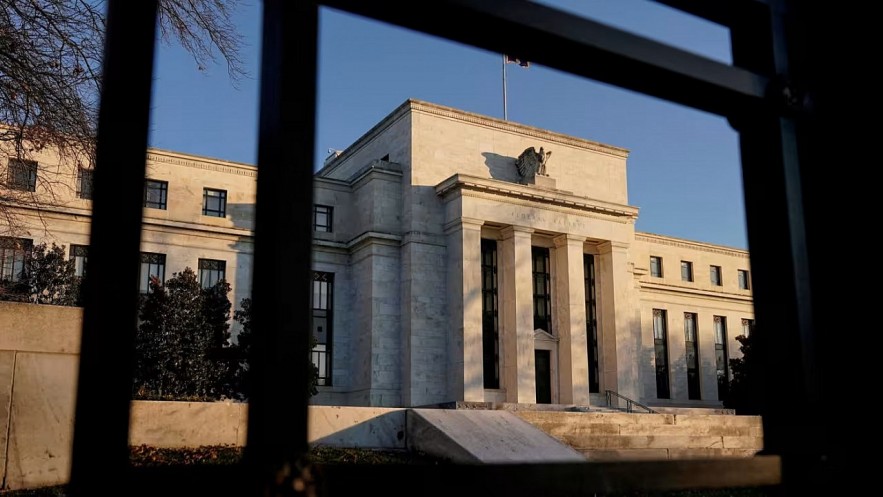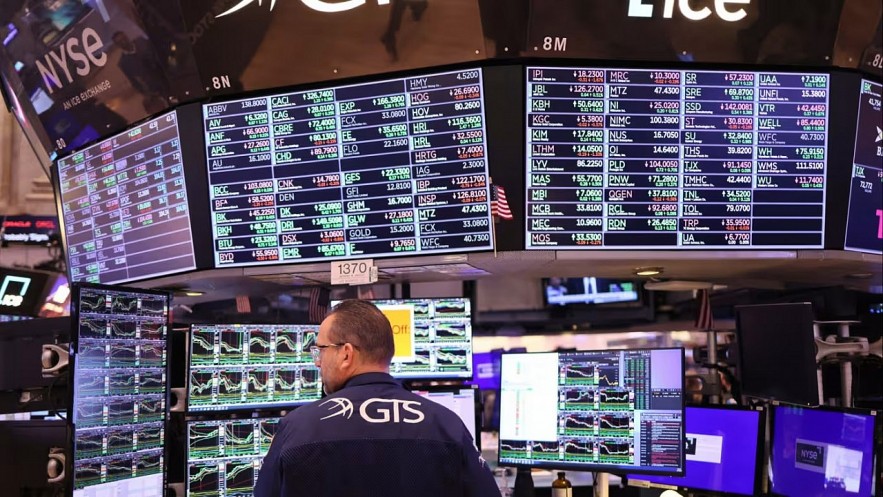(TBTCO) – US Federal Reserve (FED) policymakers have kept interest rates unchanged and are expected to cut interest rates by three-quarters of a point in 2024, as the inflation outlook improves. US Treasury yields fell and stocks rose after central bank officials forecast a 75 basis point contraction next year.
 |
|
The FOMC, the policymaking agency of the FED, decided to extend the pause in monetary policy moves that have been taking place since July 2023. Photo: Reuters |
| What’s next for FED interest rates after December meeting? |
The FED kept interest rates unchanged and signaled a three-time cut next year
US Federal Reserve (FED) Chairman Jay Powell sent the clearest signal after the final meeting of 2023 that the US central bank has completed two years of tightening monetary policy and will begin tightening monetary policy. rate cut in 2024, bringing Wall Street’s benchmark index closer to a record high as investors celebrate the prospect of lower borrowing costs.
The Fed has kept interest rates at their highest level in 22 years, but the decision comes alongside new forecasts from central bank officials pointing to a 75 basis point cut next year – a prospect More dovish on interest rates than previous predictions.
Mr. Powell’s comments after the FED’s decision also indicated a change in the bank’s perspective. “The benchmark rate is now likely at or near its peak during this tightening cycle,” he said.
| Fed policymakers expect to reduce borrowing costs to 4.6% by the end of 2024, down significantly from the previous estimate of 5.1% released in September. The forecast implies that officials will make three interest rate cuts of 75 basis points next year. |
The decision by the Federal Open Market Committee (FOMC), the Fed’s policymaking body, to keep interest rates at 5.25% to 5.5% came with the release of the dot chart. Fed, showing most officials expect interest rates to end next year at 4.5% to 4.75%.
Officials expect interest rates to fall even lower in 2025, with most officials forecasting rates between 3.5% and 3.75%. Predictions of a faster pace of rate cuts sparked a recovery in US stocks and a sharp fall in Treasury yields, with two-year yields recording their biggest daily drop since the crash of Silicon Valley Bank in March.
Yields on two-year Treasury notes, which move according to interest rate expectations, fell 0.3 percentage points to 4.43% after the Fed’s announcement. The benchmark 10-year Treasury bond yield fell 0.17 percentage points on December 13 and continued to fall in the morning session of December 14 in Asia to below 4%, for the first time since December 14. August.
The benchmark S&P 500 index rose 1.4%, closing at its highest level since January 2022. “They went from higher for longer in September to talking about cutting interest rates,” said Priya Misra, portfolio manager at JPMorgan Asset Management. “They are behind the inflation curve, but they probably want to be ahead of the curve in terms of the slowdown.”
The market expects profits power will start cutting decreased in May/2024
In a statement, the Fed outlined the conditions under which it would consider “any additional consolidation that may be appropriate to bring inflation back to 2% over time” – soft language suggests the central bank may not see the need to raise interest rates any further.
 |
| The stock market reacted positively after the FED’s interest rate cut signal. |
Mr. Powell reiterated that the central bank is committed to proceeding “carefully” with future interest rate decisions in the expectation that economic growth will cool and there has been “real progress” in pushing back inflation .
He also said the Fed does not want to restrict the economy any longer than necessary. “We are aware of the risk that we will delay too long,” Mr. Powell said, referring to waiting too long to cut interest rates. “We know it’s a risk and we’re very focused on not making that mistake.”
After that, the FED Chairman added that he would not wait until inflation returns to 2% to start cutting interest rates, because “we want to ease restrictions on the economy before” that time. “so as not to exceed the limit”.
| The Fed’s economic forecasts say policymakers expect inflation to return to 2% by 2026. They also show officials still expect the unemployment rate to rise slightly, reaching 4.1% next year, as growth slows but remains positive. That would be a big win for the Fed, especially considering that many forecasters have been predicting an impending recession as recently as late spring and early this summer. |
The latest decision comes as the Fed tries to keep monetary policy tight enough to push inflation down to its 2% target without damaging the economy and causing too many jobs.
Some futures market traders had expected the Fed to begin reducing borrowing costs as early as March 2024, despite inflation data this week and a solid jobs report late last week. has led many to bet that interest rate cuts will begin in May next year.
Before the Dec. 13 rate announcement, traders had bet that rates could fall more than 1 percentage point next year. Forecasts from FED officials for the unemployment rate are virtually unchanged from September, with officials still expecting the unemployment rate to increase only slightly to 4.1% in 2024, from 3.0%. 7% currently. However, estimates for core inflation, measured by the personal consumption expenditure index, have eased slightly, with officials expecting it to reach 2.4% in 2024 and 2.2% in 2025.
In September, median forecasts showed inflation reaching 2.6% in 2024 and 2.3% the following year. To consider reducing interest rates, the FED needs to believe that inflation is tending to return to 2% in a sustainable way.
If slower consumer price growth is accompanied by a sharp rise in unemployment, the reason for cuts will be clear. The question is what happens if the economy holds up when inflation falls. Some officials such as John Williams – President of the New York Fed and Christopher Waller – Governor of the Fed, believe that loosening monetary policy may still be necessary so that interest rates, once adjusted for inflation, do not become should be too restrictive for households and businesses./.
